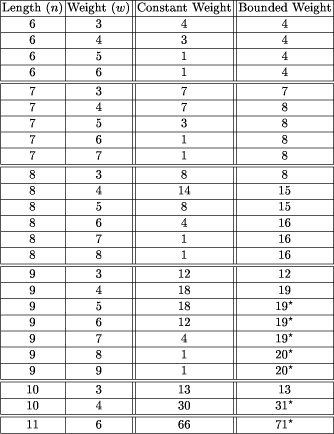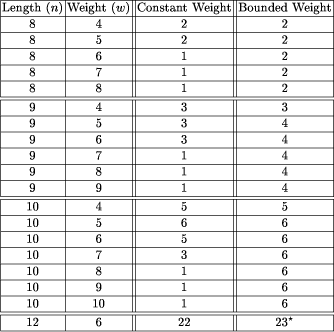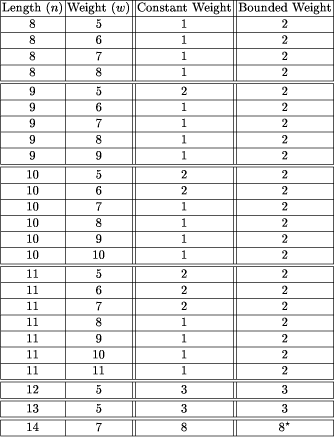| Submission Procedure |
A Note on Bounded-Weight Error-Correcting CodesRussell Bent, Michael Schear, and Lane A. Hemaspaandra Gabriel Istrate Abstract: This paper computationally obtains optimal bounded-weight, binary, error-correcting codes for a variety of distance bounds and dimensions. We compare the sizes of our codes to the sizes of optimal constant-weight, binary, error-correcting codes, and evaluate the differences. Key Words: error-correcting codes, bounded-weight codes, constant-weight codes, experimental algorithms, heuristic algorithms, exact solutions. 1 IntroductionOne goal of coding theory is to construct classes of codes having optimal size. Studies have investigated versions of this problem for classes of codes with various regularity properties, such as linear codes over finite fields [Brouwer], binary self-dual codes [Conway, Pless and Sloane (92)], mixed binary-ternary codes [Brouwer et al. (97)], and various classes of spherical codes [Sloane]. Two such important cases concern determining the values of A(n, d) and A(n, d, w), where A(n, d) is the number of codewords in the largest binary code of length n having minimum distance d, and A(n, d, w) is the number of codewords in the largest binary code of length n, minimum distance d, and weight w. Optimal values for A(n, d) and A(n, d, w) have been tabulated in [Litsyn, Rains and Sloane] and [Rains and Sloane], respectively. It is conceivable that significant improvements in optimal code size could be obtained by relaxing the restriction on the code weight in the definition of A(n d, w) from "equal to w" to "upper-bounded by w," because there would then be a greater number of words potentially available for inclusion in the codes. We present optimal, bounded-weight, binary, error-correcting codes for a variety of distance bounds and dimensions. The method we employ to obtain the optimal codes is based on the observation that finding optimal bounded-weight codes can be transformed to finding the size of a maximum clique in a suitably defined graph. The clique-finding is accomplished primarily using the branch and bound search used in [Brouwer et al. (97)], (see also [Applegate and Johnson] and the discussion later in this paper). Page 817 2 PreliminariesLet F be some finite set of characters - the alphabet. A word of length n over F is an element of Fn. A code over F of size n is a set of words of length n over F. A code over the alphabet {0, 1} is called binary. Throughout this paper, we use the alphabet F = {0, 1}. The distance, d, of a code is the smallest Hamming distance between
any two codewords in the code. If we have two codewords, x and y,
both of length n, we can represent these two words as x1x2x3
... xn and y1y2y3
... yn , where xj is the jth
bit in x. The Hamming distance between x and y is
the size of the set, The standard reduction of finding optimal values of A(n d) and A(n, d, w) to the problem of determining a maximum clique in a graph is as follows. The graph's vertices represent binary strings of length n (and legal weight, when appropriate). Two vertices are joined by an edge if and only if their Hamming distance is at least d. It is easily seen that the connection between optimal code size and maximum clique in a suitably constructed graph carries over to the case of bounded-weight codes, and we indeed use exactly that in this paper. 3 Results and DiscussionThe constant-weight bounds, many tight, tabulated by Sloane were obtained from a variety of sources and methods [Rains and Sloane]. An elegant method for finding optimal codes of constant-weight is to use an algebraic formula. Methods of creating such formulas for certain cases are presented in [Brouwer et al. (90)]. No such algebraic formulas for instances of bounded-weight codes are available yet. In the absence of such a method we tried various other methods for obtaining good sets of codewords. Many of the algorithms used were bounded-weight variants of those suggested in the literature for calculating good constant-weight codes. These methods included simulated annealing [El Gamel et al. (87)], genetic algorithms [Vaessens, Aaarts and van Lint (93)], and a randomized greedy heuristic search. The codes generated by these methods were beaten or equaled by our final method of obtaining codes, which was creating an appropriate graph and seeking a large (in fact, usually maximum-size) clique via different clique-finding algorithms. Since the problem of finding a maximum clique in a graph has been thoroughly investigated [Johnson and Trick (93)], it is natural to use a reduction to this problem as our basis for finding good bounded-weight codes. The reduction is accomplished by creating the graph of possible codewords acceptable under the parameters for length and weight. Each possible codeword is represented by a vertex in the graph. If two codewords have a proper Hamming distance, then an edge is placed between them. The largest clique in the graph is representative of a maximum set of codewords such that the set meets all the parameters. Page 818 We used two clique-finding algorithms suggested in [Brouwer et al. (97)]. The first algorithm is a basic branch and bound search. In the worst case, it will search all possible combinations of nodes for cliques, but in practice it keeps track of a best solution and travels only those paths that have the potential to beat the current best solution. This algorithm will always find a maximum-size clique. We used a publicly available coding from [Applegate and Johnson], (see also [Carragan and Pardalos (90)]). The second algorithm is a variant of semi- exhaustive greedy search. This algorithm may not always find the largest clique. The algorithm begins by creating two sets of nodes. The first set is nodes that are part of the clique being created and the second set is nodes that can be added to the clique set without disrupting the clique property of the set. This available node set initially contains all the nodes and the clique set is initially empty. A node is chosen from the nodes in the available set. Those nodes that are not connected to the chosen node are eliminated from the available set. This process is repeated until the number of nodes in the available set drops below a user-defined threshold, y. Once y is reached, the branch and bound algorithm is employed on the available set. The nodes are selected as follows. For a user-defined number x, x nodes are chosen at random from the available node set. The node with the most edges in the set of x nodes is chosen. We used a publicly available coding, originally by Johnson, as modified by Applegate and Johnson (see [Applegate and Johnson], also [Johnson et al. (91)]). For our purposes, good results were achieved when x = 0.1s, where s is the number of nodes in the original graph, and y = 100. We ran the algorithm a thousand times in order to increase the odds of finding the largest clique. The branch and bound algorithm was used on parameters where the optimal constant-weight code sizes were known and the search spaces were small enough to allow results to be obtained in reasonable amounts of time. For example, it took forty-one CPU minutes to calculate A(9, 4, 4) and this was considered reasonable. On the other hand, the calculation of A(9, 4, 7) was terminated as it was taking an unreasonable amount of time. However, running the greedy algorithm one thousand times on A(9, 4, 7) took just under seventy two CPU minutes.1 From our results, it is now clear that, with regards to changing from
constant-weight to bounded-weight, there is little or no increase in number
of codewords in the best code until constant-weight codes become handicapped
with a decrease in search space. (As the weight of a constant-weight code
increases, the search space increases initially, but then begins to decrease
once w >
1These CPU times were obtained using a Sun Ultra 10. Page 819 Table 1: Code sizes for distance 4. Note: The values superscripted with "*" were obtained through greedy search. Clearly, a lower bound for bounded-weight codes is
Results from the two clique-finding algorithms seem to usually merely meet this bound, and occasionally (see discussion below) beat it. Tables 1, 2, and 3 illustrate these results. It must be noted that the performance of the semi-exhaustive search has only been tested on those parameters where the entire graph can be created and stored in memory. It remains to be seen if patched codes can be matched or beaten easily in other cases. We now discuss more broadly our results. As noted above, in most cases the best bounded-weight codes we obtain are in fact such that codes of optimal sizes are also provided by "patching together" existing optimal constant-weight codes. However, this does not mean that that part of our paper makes no contribution. Before our paper, it remained possible that there existed bounded-weight codes for these cases having size larger than the patched-together codes. Our paper, via in many cases (namely, in all table lines other than the nine superscripted with Page 820 Table 2: Code sizes for distance 6. Note: The value superscripted with "*" was obtained through greedy search. asterisks) establishing the maximum size achievable by any legal code obeying the parameters, removes this possibility. Additionally, our work shows that in some cases the obvious patching together that we mention does not achieve a maximum-sized code. For example, the size 16 code obtained for A(8, 4, 6) is such a case (as, since A(8, 4, 2) obviously is exactly 4, the relevant patched-together codes are of size 8 + 4 and of size 14 + 1, and thus both fall short of size 16). We now turn to the question of whether, in light of our results, bounded-weight
codes seem wise to use. Bounded-weight codes obviously give no fewer codewords
(in a maximum-sized code) that their sister constant-weight codes. Our
tables show that in many cases they give strictly more words. Of course,
as w increases beyond However, this does not necessarily mean that it is wise to use bounded-weight
codes. As our results show, even maximum-sized bounded-weight codes give
scant improvement over their sister constant-weight codes, at least in
the range - Page 821 Table 3: Code sizes for d = 8. Note: The value superscripted with "*" was obtained through greedy search. of error detection. Bounded-weight codes sacrifice this extra line of protection. However, as a final comment, we mention that maximum-sized codes may have potential future uses in alternate models of computation/communication. Though this is currently hypothetical, it is not entirely implausible. Consider for example some future alternate model of information (storage or) transmission - perhaps biological, perhaps electrical, perhaps something else - in which each (stored or) transmitted "word" has n binary "bits" (which might be represented via genetic material, or via charged particles in a given location, or so on) but such that, due to constraints of the (storage or) transmission medium, if more than w of the bits are "on" there is the possibility that the information in the word will degrade, or that the computer or transmission lines will incur physical damage. Possible reasons might include power limitations, heat dissipation, or attraction between biological components. In this admittedly extremely hypothetical setting, bounded-weight codes might play a valuable role, as their limitation would be exactly suited to the physical constraints imposed by the (storage or) transmission medium. Page 822 Acknowledgments We thank the anonymous J.UCS referees for helpful comments. The authors were supported in part by NSF grants 9322513, 9513368/DAAD-315-PRO-fo- ab, 9701911, 9725021, and 9815095/DAAD-315-PPP-gü-ab. This work was done while Gabriel Istrate was attending the University of Rochester. References[Applegate and Johnson] D. Applegate and D. Johnson. Clique-finding program dfmax.c. Available from ftp://dimacs.rutgers.edu/pub/challenge/graph/solvers. [Brouwer et al. (97)] A. Brouwer, K. Hamalainen, P. Ostergard, and N. Sloane. Bounds on mixed binary/ternary codes. IEEE Transactions on Information Theory, IT-44, 1 (1997), 1334-1380. [Brouwer] A. Brouwer. Bounds on the minimum distance of linear codes. Available at http://www.win.tue.nl/math/dw/voorlincod.html. [Brouwer et al. (90)] A. Brouwer, J. Shearer, N. Sloane, and W. Smith. A new table of constant weight codes. IEEE Transactions on Information Theory, IT-36, 6 (1990), 1334-1380. [Carragan and Pardalos (90)] R. Carraghan and P. Paradalos. An exact algorithm for the maximum clique problem. Operations Research Letters, 9 (1990), 375-382. [Conway, Pless and Sloane (92)] J. Conway, V. Pless, and N. Sloane. The binary self-dual codes of length up to 32: A revised enumeration. J. Combinatorial Theory, Series A, 60, 2 (1992), 183-195. [El Gamel et al. (87)] A. El Gamel, L. Hemachandra, I. Shperling, and V. Wei. Using simulated annealing to design good codes. IEEE Transactions on Information Theory, IT-33, 1 (1987), 116-123. [Johnson et al. (91)] D. Johnson, C. Aragon, L. McGeoch, and C. Schevon. Optimization by simulated annealing: An experimental evaluation - Part II, graph coloring and number partitioning. Operations Research, 39, 3 (1991), 378-406. [Johnson and Trick (93)] D. Johnson and M. Trick, editors. Cliques, Coloring and Satisfiability: Second DIMACS Implementation Challenge, number 26 in DIMACS series in Discrete Mathematics and Theoretical Computer Science. A.M.S., 1993. [Litsyn, Rains and Sloane] S. Litsyn, E. Rains, and N. Sloane. Table of nonlinear binary codes. Available at http://www.research.att.com/~njas/codes/And. [Rains and Sloane] E. Rains and N. Sloane. Table of constant weight binary codes. Available at http://www.research.att.com/~njas/codes/Andw/. [Sloane] N. Sloane. Tables for various types of spherical codes. Available from http://www.research.att.com/~njas/. [Vaessens, Aaarts and van Lint (93)] R. Vaessens, E. Aarts, and J. van Lint. Genetic algorithms in coding theory: A table for A3(n, d). Discrete Applied Mathematics, 45, 1 (1993), 71-87. Page 823 Appendix: CodesThis section presents codes that give the values in Tables 1, 2, and 3. A(6, 4, 3) A(6, 4, 4) A(6, 4, 5) A(6, 4, 6) A(7, 4, 3) A(7, 4, 4) A(7, 4, 5) A(7, 4, 6) A(7, 4, 7) A(8, 4, 3) A(8, 4, 4) A(8, 4, 5) A(8, 4, 6) A(8, 4, 7) A(8, 4, 8) A(9, 4, 3) Page 824 A(9, 4, 4) A(9, 4, 5) A(9, 4, 6) A(9, 4, 7) A(9, 4, 8) A(9, 4, 9) A(10, 4, 3) A(10, 4, 4) Page 825 A(11, 4, 6) A(8, 6, 4) A(8, 6, 5) A(8, 6, 6) A(8, 6, 7) A(8, 6, 8) A(9, 6, 4) A(9, 6, 5) A(9, 6, 6) A(9, 6, 7) A(9, 6, 8) A(9, 6, 9) A(10, 6, 4) A(10, 6, 5) A(10, 6, 6) A(10, 6, 7) A(10, 6, 8) A(10, 6, 9) A(10, 6, 10) A(12, 6, 6) A(8, 8, 5) A(8, 8, 6) A(8, 8, 7) A(8, 8, 8) A(9, 8, 5) Page 826 A(9, 8, 6) A(9, 8, 7) A(9, 8, 8) A(9, 8, 9) A(10, 8, 5) A(10, 8, 6) A(10, 8, 7) A(10, 8, 8) A(10, 8, 9) A(10, 8, 10) A(11, 8, 5) A(11, 8, 6) A(11, 8, 7) A(11, 8, 8) A(11, 8, 9) A(11, 8, 10) A(11, 8, 11) A(12, 8, 5) A(13, 8, 5) A(14, 8, 7) Page 827 |
|||||||||||||||||
 .
The weight, w, of a binary word, x, is equal to the number
of 1s in x. For a constant-weight (w) code, every word in
the code has the same weight, w. In a bounded-weight (w)
code, every word has at most w ones.
.
The weight, w, of a binary word, x, is equal to the number
of 1s in x. For a constant-weight (w) code, every word in
the code has the same weight, w. In a bounded-weight (w)
code, every word has at most w ones.  .
However, in the case of bounded-weight codes, the search space continues
to increase as w approaches n.) It is important to note that
where there are increases in the number of words in bounded-weight codes
over constant-weight codes, these new bounded-weight codes can often be
obtained trivially. For example, if w
.
However, in the case of bounded-weight codes, the search space continues
to increase as w approaches n.) It is important to note that
where there are increases in the number of words in bounded-weight codes
over constant-weight codes, these new bounded-weight codes can often be
obtained trivially. For example, if w  d, a bounded-weight code can be created by taking the constant-weight
code at A(n, d, w), w
d, a bounded-weight code can be created by taking the constant-weight
code at A(n, d, w), w 


 the size of the word-space of bounded-weight codes becomes extremely rich
relative to that of constant-weight codes (which starting at weight
the size of the word-space of bounded-weight codes becomes extremely rich
relative to that of constant-weight codes (which starting at weight  have contracting word-spaces as w increases), and even for smaller
(but nonzero) values of w their word space is of course richer -
which is exactly what opens up the possibility of larger-sized codes.
have contracting word-spaces as w increases), and even for smaller
(but nonzero) values of w their word space is of course richer -
which is exactly what opens up the possibility of larger-sized codes. 
